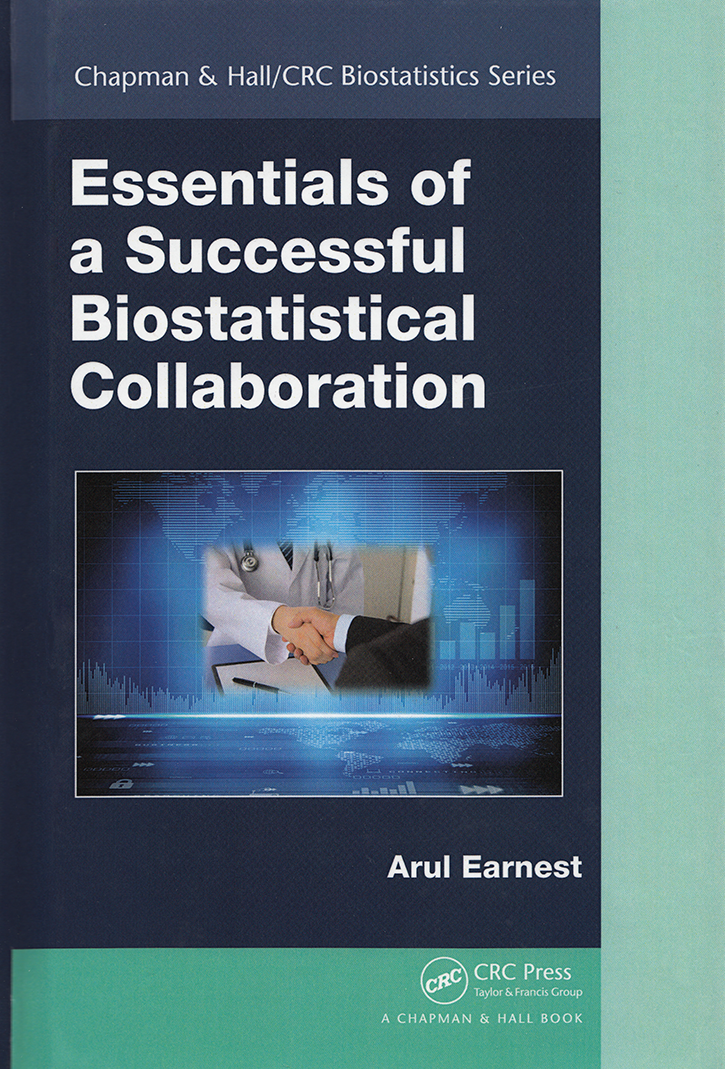Essentials of a Successful Biostatistical Collaboration by Arul Earnest is a unique approach to a biostatistics text in that the focus is not purely on study design and statistical analyses. While these topics are certainly discussed, equal attention is given to topics such as planning, project management, and effective communication that are important for any biostatistician who is collaborating with a research team.
The book begins with an overview of observational study designs as well as randomized control trials. Then the discussion turns to data management, power and sample-size calculations, and a variety of statistical analyses. Earnest provides an overview of statistical methods ranging from basics such as t tests and correlation to more advanced topics such as Cox regression and ARIMA models, and each topic is accompanied by the corresponding Stata commands and output. The following chapters give advice on both verbal and written communication, project management, and how to manage collaborations.
This book is a practical resource that will appeal to biostatisticians, epidemiologists, and other members of clinical research teams as well as students who plan to work in this field.
Preface
Acknowledgements
Author
1. OBSERVATIONAL STUDY DESIGNS
Introduction
Comparative Features between Cohort, Case–Control and Cross-Sectional Studies
Cross-Sectional Study Design
Case–Control Study Design
Cohort Study Design
Ecological Study Design
Selecting the Appropriate Study Design
Key Questions to Ask a Clinician
Common Mistakes
Online Tools and Resources
A Collaborative Case Study
Study Summary
Alternative Study Designs
Key Learning Points
References
2. RANDOMISED CONTROLLED TRIALS
Introduction
Phases and Types of Trials
Types and Features of Randomisation
Controls and Blinding
Other Types of RCTs
Cluster RCT
Crossover Trials
Stepped Wedge Cluster RCT
Equivalence Trials
Data and Safety Monitoring Board
Choosing Outcome Measures for a Trial
Key Questions to Ask a Clinician
Tools and Resources
A Collaborative Case Study
Study Summary
Alternate Method of Randomisation
Significance of Trial
Rigorous and Appropriate Analysis
Key Learning Points
References
3. FORM DESIGN AND DATABASE MANAGEMENT
Introduction
Principles of Questionnaire Design
Open-Ended versus Closed-Ended Questions
Multiple-Response Questions
Double-Barrelled Questions
Wording of Questions
Ordinal Scales
Validation
Translation
Types of Variables and Scales of Measurement
Finding a Suitable Database Software for Your Study
Efficient Ways to Create and Manage an Excel Database
Multiple-Response Questions
Repeated Measurements
Missing Data
Data Validation in Excel
Limitations to Excel
Key Questions to Ask a Clinician
Common Mistakes to Avoid
Questionnaire Design
Database Design
Tools and Resources
A Collaborative Case Study
Key Learning Points
References
4. SAMPLE SIZE AND POWER CALCULATIONS
Introduction
Linking Hypothesis Testing and Sample Size
Ingredients in a Sample Size Calculation
Objective of the Study
Type 1 Error (Level of Significance)
Type 2 Error (1 – Power)
Variability
The Effect Size
Two-Sided versus One-Sided Tests
Other Considerations
Commonly Performed Sample Size Calculations
Comparing Proportions between Two Independent Groups
Comparing Means between Two Independent Groups
Estimating Hazard Ratios in a Survival (Time to Event) Analysis
Estimating Coefficients in a Linear Regression Model
Estimating Odds Ratios in a Logistic Regression Model
Estimating a Kappa Coefficient in an Agreement Study
Repeated Measures Analysis
Cluster Randomised Trials
Key Questions to Ask a Clinician
Common Mistakes
Tools and Resources
A Collaborative Case Study
Key Learning Points
References
5. STATISTICAL ANALYSIS PLAN
Introduction
Choosing the Appropriate Statistical Method
Common Statistical Hypotheses and Tests
Univariate Analysis
Estimate Mean
Estimate Proportion
Bivariate Analysis
Compare Means in Two Groups
Assumptions of Independent Student’s t-Test
Non-Parametric Equivalent: Mann–Whitney U Test
Compare Means in More Than Two Groups
Assumptions of the ANOVA Test
Non-Parametric Equivalent: Kruskal–Wallis Test
Compare Means within the Same Group
Calculate Correlation between Two Continuous Variables
Compare Proportions
Compare Survival
Measure Agreement (Continuous Variables)
Measure Agreement (Categorical Variables)
Relative Risk Measures
Multi-Variate Analysis
Continuous Outcome Measure–Linear Regression Model
Assumptions of the Linear Regression Model
Binary Outcome Measure–Binary Logistic Regression Model
Predicted Probability
Ordinal Outcome Measure–Ordinal Logistic Regression
Categorical Outcome Measure–Multinomial Logistic Regression
Count Data–Poisson Regression Model
Survival Data–Cox Regression Model
Generalised Estimating Equations
Clinical Examples
ARIMA Models
Clinical Example
Issues to Note
Crossover Trials
Cluster RCT
Intention-to-Treat versus Per-Protocol Analysis
Missing Data
Multiplicity
Key Questions to Ask a Clinician
A Collaborative Case Study
Key Learning Points
References
6. EFFECTIVE COMMUNICATION SKILLS
Introduction
The Initial Meeting
Difficulty in Understanding Medical Jargon
Challenges in Explaining Statistical Concepts to Clinicians
Using the Venn Diagram
Using the Gaussian Curve
Simplifying Language
Employing Drawings
Effective Presentation Skills
Tips and Tricks within Microsoft PowerPoint for a Statistical Presentation
Actual Presentation
Preparing a Poster
Checklist for Preparing and Presenting an Effective Research Poster
Content
Layout and Format
Narrative Description
Some Tips on Creating a Poster in Microsoft PowerPoint
Tools and Resources
A Collaborative Case Study
Key Learning Points
References
7. EFFECTIVE WRITING SKILLS
Introduction
Writing a Statistical Analysis Plan for a Grant Application
Specific Aims and Hypotheses
Background and Clinical Significance
Preliminary Studies/Progress Report
Methods/Approach
CONSORT Statement
STROBE Statement
PRISMA Statement
STARD Statement
Writing for a Publication – First-Author Publication
Selecting the Journal
Instructions for Authors
Tips for Formatting
Preparing a Manuscript
Abstract
Tips for the Abstract Section
Introduction
Tips for the Introduction Section
Methods
Results
Tips for the Results Section
Discussion and Conclusion
Tips for the ‘Discussion and Conclusion’ Section
Creating a Draft
Writing for a Publication – Collaborative Publication
Additional Tips When Writing for a Collaborative Publication
Resources
Key Learning Points
References
8. PROJECT MANAGEMENT: BEST PRACTICES
Introduction
Creation of a Project File
Database Security and Confidentiality
Database Confidentiality
Database Security
Standard Operating Procedures
Ensuring Consistency and Reproducibility in the Results
Managing Multiple Projects
Obtaining Mentorship
Poor Project Management Skills (The ‘Not’s to Avoid)
A Collaborative Case Study
Key Learning Points
References
9. MANAGING COLLABORATIONS
Introduction
Getting the Most Out of a Collaboration
Providing Collaboration in a Large Complex Institution – Hub-and-Spoke Model
Providing Consultations
Seven Faces of Collaborators
The Auto-Pilot
The Pseudo-Statistician
The ‘Harry Houdini’
The p-Value Hunter
The Sceptic
The Passive Collaborator
The Faceless Collaborator
Useful Strategies to Adopt in Successfully Managing a Collaboration
Responding to Unreasonable Work Requests
Reasoning with a Collaborator Who Engages in Data Dredging
Coping with an Unreasonable Request on Turnaround Time
Negotiating Authorship
International Collaborators
General Statistical Conferences
Biostatistics Conferences
Key Learning Points
References
10. HOW NOT TO DESIGN, ANALYSE AND PRESENT YOUR STUDY
Introduction
Choosing the Inappropriate Study Design
Selecting Too Few Subjects in the Study
Incorrect Use of Randomisation
Undertaking Incorrect Statistical Tests
Not Checking for the Assumptions Behind the Test
Data Dredging
Presenting Tables and Figures Inappropriately
Reporting and Interpreting Data Inappropriately
Conclusion
Key Learning Points
References
11. VIEWS FROM THE GROUND: A SURVEY AMONG BIOSTATISTICIANS AND A CHAT WITH CLINICIANS
Introduction
Survey Methodology and Profile of Respondents
Problems Ever Faced in Collaborating with Clinicians
Training on Collaboration/Consultation Skills
Frequency of Performing Selected Tasks as a Biostatistician
Issues to Address in Order to Enhance Greater Collaborations
Skills Most Important to Gain to Improve on Collaborations with Clinicians
Formal Postgraduate Degrees
Short Courses
Online Course
Journals (Development and Application of Statistics in Medicine)
Views from Clinicians Who Have Collaborated with Biostatisticians
Interview with Dr. Leong Khai Pang, MBBS, FRCPE, FAMS
Interview with Professor Nick Paton, MB BChir (Cambridge), MRCP (Internal Medicine) (London), MD (Cambridge), FRCP (Edinburgh), DTM & H (London)
Interview with Professor John Augustus Rush, MD, AB
Interview with Professor John McNeil, AM, MBBS (Adelaide), MSc (London), PhD (Melbourne), FRACP, FAFPHM
Conclusion
Appendix: Sample Survey Questionnaire
Key Learning Points
References


